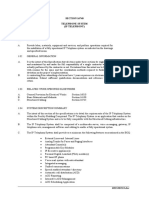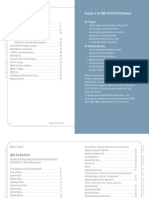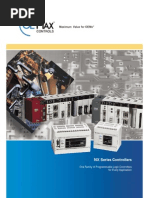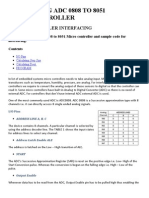Specification For Otn/Sonet/Sdh Digital Communications Network Tester System
Uploaded by
ahmedelhajsaSpecification For Otn/Sonet/Sdh Digital Communications Network Tester System
Uploaded by
ahmedelhajsaSOLICITATION NUMBER N00173-06-R-CB03
ATTACHMENT NO. 1
PAGE1
SPECIFICATION FOR OTN/SONET/SDH DIGITAL
COMMUNICATIONS NETWORK TESTER SYSTEM
1. INTRODUCTION
The Naval Research Laboratory analyzes, develops, tests, evaluates, and uses fiber optic digital communications networks. Some of the networks and components are developed at the Laboratory, while others
are purchased from private industry, and many of them follow commercial standards, such as the Optical
Transport Network (OTN), Synchronous Optical Network (SONET), and Synchronous Digital Hierarchy
(SDH) standards. The Laboratorys work with such hardware includes but is not limited to:
Verifying that networks and components comply with recommendations, standards, and specifications
from the American National Standards Institute (ANSI), the International Telecommunication Union
(ITU), and Telcordia Technologies.
Verifying that networks and components from different sources, whether industry or the Laboratory
itself, operate correctly together.
Evaluating how Laboratory and industrial hardware responds to network signals with various structures and payloads and with optional errors and alarms, and analyzing such signals generated by network hardware.
To support this work, the Laboratory requires a digital communications network tester system.
2. SCOPE
This procurement is for a digital communications network tester system capable of testing OTN, SONET,
and SDH networks at speeds up to 10.7 Gb/s. The system must be able to generate and analyze jitter and
wander and must have optical and electrical interfaces.
3. TECHNICAL REQUIREMENTS
The contractor shall provide a digital communications network tester system that meets or exceeds the
desired specifications described below.
3.1. Performance Specifications
SONET/SDH
Generate and analyze SONET/SDH signals with bit rates of 9953, 2488, 622, 155, and 52 Mb/s.
Generate and analyze VT1.5/2/6 and STS-1/3c/12c/48c/192c SONET mappings.
SOLICITATION NUMBER N00173-06-R-CB03
ATTACHMENT NO. 1
PAGE2
Generate and analyze VC-12, VC-11, VC-2, VC-3, VC-4, and VC-4-4c/16c/64c AU-4 SDH mappings and VC-12, VC-11, VC-2, and VC-3 AU-3 SDH mappings.
Generate and analyze PRBS 215 1, PRBS 223 1, PRBS 231 1, and 16-bit user word test patterns.
Insert bit, B1, B2, B3, FAS, BIP, and REI errors.
Insert SONET/SDH alarms.
Detect and report SONET/SDH errors.
Detect and report SONET/SDH alarms with 100 ms resolution.
Detect and report user-selectable SONET/SDH errors and alarms with 0.1 ms resolution. The selectable errors and alarms must include payload errors plus SEF/OOF, LOF, AIS, RDI, FAS, B1,
B2, B3, and REI.
OTN
Generate and analyze OTU-1 and OTU-2 signals with bit rates of 10709 and 2666 Mb/s.
Generate the following client signals: SONET/SDH, PRBS 223 1, PRBS 231 1, and 16-bit user
word.
Insert OTN errors and alarms.
Insert correctable FEC errors (up to and including the maximum number of correctable errors),
uncorrectable FEC errors, and FEC errors at a user-specified position in the frame.
Analyze OTU-1 and OTU-2 signals, both with and without applying FEC.
Detect and report OTN errors and alarms.
Jitter and Wander
Generate jitter and wander at 10709, 9953, 2666, 2488, 622, and 155 Mb/s in compliance with
ITU-T Recommendations O.172 and O.173.
Analyze jitter and wander at 10709, 9953, 2666, 2488, 622, and 155 Mb/s in compliance with
ITU-T Recommendations O.172 and O.173 and with error no greater than 20 mUIpp.
For jitter, measure phase hits, jitter transfer function (JTF), and maximum tolerable jitter (MTJ).
For wander, measure time interval error (TIE), maximum time interval error (MTIE), and time
deviation (TDEV).
SOLICITATION NUMBER N00173-06-R-CB03
ATTACHMENT NO. 1
PAGE3
3.2. Interface Specifications
Optical:
The transmitter(s) must emit a nominal wavelength of 1550 nm.
The receiver(s) must accept wavelengths from 1260 to 1360 nm and from 1430 to 1580 nm.
The system must include adapters sufficient to connect all ports to FC, SC, and LC optical connectors.
Electrical: The system must have single-ended and differential electrical interfaces for both transmit
and receive covering 51 Mb/s to 10.7 Gb/s.
Local control: The system must have a built-in user interface for local control.
Remote control: The system must have either an Ethernet or GPIB interface (or both) over which it
may be controlled by a remote computer.
3.3. General Specifications
Size: The volume must not exceed 80 000 cm3. Neither the height, width, nor depth shall exceed 0.75
m.
Mass/weight: 35 kg or 77 lbs. maximum.
The system must be supplied with either a case or cover(s) for transportation.
Power: The system must accept 110 to 220 V at 50 to 60 Hz and dissipate 750 VA maximum.
Temperature: The system must operate within specifications at temperatures of 10 to 40 C.
4. SOFTWARE
The system must be supplied with all driver or user interface software and licenses which are either necessary to allow remote control or customarily provided to the public in a commercial transaction.
5. DOCUMENTATION
The system must be supplied with hardware and software user manuals as well as any other documentation customarily provided to the public in a commercial transaction.
6. WARRANTY
The contractor shall provide a standard commercial warranty for the system.
You might also like
- Mobile Network Optimization: A Guide for 2G and 3G Mobile Network OptimizationFrom EverandMobile Network Optimization: A Guide for 2G and 3G Mobile Network Optimization3.5/5 (3)
- Tender For SCADA System For Distribution Substations and Associated Telecommunication System100% (2)Tender For SCADA System For Distribution Substations and Associated Telecommunication System157 pages
- Section Telecommunication Systems Rev 02No ratings yetSection Telecommunication Systems Rev 0255 pages
- BICSI RCDD Registered Communications Distribution Designer Exam Prep And Dumps RCDD-001 Exam Guidebook Updated QuestionsFrom EverandBICSI RCDD Registered Communications Distribution Designer Exam Prep And Dumps RCDD-001 Exam Guidebook Updated QuestionsNo ratings yet
- Signal Integrity: From High-Speed to Radiofrequency ApplicationsFrom EverandSignal Integrity: From High-Speed to Radiofrequency ApplicationsNo ratings yet
- B. Ethernet Fibre Transceiver: Tandard Onstruction Specifications OadsNo ratings yetB. Ethernet Fibre Transceiver: Tandard Onstruction Specifications Oads1 page
- Viavi T-Berd®/Mts-5800 Series: Measu Rement DevicesNo ratings yetViavi T-Berd®/Mts-5800 Series: Measu Rement Devices4 pages
- Connection-Oriented Networks: SONET/SDH, ATM, MPLS and Optical NetworksFrom EverandConnection-Oriented Networks: SONET/SDH, ATM, MPLS and Optical NetworksNo ratings yet
- tps_atc_2025-01-17-17-12-44_41e6e209f2c85e129f814002f08bf934No ratings yettps_atc_2025-01-17-17-12-44_41e6e209f2c85e129f814002f08bf93417 pages
- M.P. MADHYA KSHETRA VIDYUT VITARAN CO. LTD. BHOPALNo ratings yetM.P. MADHYA KSHETRA VIDYUT VITARAN CO. LTD. BHOPAL13 pages
- Section 271500 Communications Horizontal CablingNo ratings yetSection 271500 Communications Horizontal Cabling12 pages
- WAN TECHNOLOGY FRAME-RELAY: An Expert's Handbook of Navigating Frame Relay NetworksFrom EverandWAN TECHNOLOGY FRAME-RELAY: An Expert's Handbook of Navigating Frame Relay NetworksNo ratings yet
- SURPASS HiT 7050 FlatPack Technical DescriptionNo ratings yetSURPASS HiT 7050 FlatPack Technical Description67 pages
- May Do Ip - Ds (En) - Otm2612 v2.04 (Eth, SDH and Otn)No ratings yetMay Do Ip - Ds (En) - Otm2612 v2.04 (Eth, SDH and Otn)18 pages
- 11 General Technical Requirement of FOTE PDFNo ratings yet11 General Technical Requirement of FOTE PDF3 pages
- FONST 5000 U Series Packet Enhanced OTN Equipment Product Description JNo ratings yetFONST 5000 U Series Packet Enhanced OTN Equipment Product Description J270 pages
- Advanced Modulation Techniques: Telecom Titans: Building the Connected World, #2From EverandAdvanced Modulation Techniques: Telecom Titans: Building the Connected World, #2No ratings yet
- Interfacing Adc 0808 To 8051 Micro Controller - A Knol by Amol ShahNo ratings yetInterfacing Adc 0808 To 8051 Micro Controller - A Knol by Amol Shah9 pages
- 3.5. Creating and Downloading An Employee Resume - en-USNo ratings yet3.5. Creating and Downloading An Employee Resume - en-US40 pages
- Cambridge IGCSE First Language English Workbook (Cambridge International IGCSE) New Book0% (1)Cambridge IGCSE First Language English Workbook (Cambridge International IGCSE) New Book1 page
- Q1:What's The Meaning of Each Status of Wi-Fi Indicator?: (Revised On February 25, 2015)No ratings yetQ1:What's The Meaning of Each Status of Wi-Fi Indicator?: (Revised On February 25, 2015)7 pages
- Top Artists DNA Graphic From Spotify Data N-Gen ArtNo ratings yetTop Artists DNA Graphic From Spotify Data N-Gen Art1 page
- Deadlocks: Waiting Waiting Not Held ThisNo ratings yetDeadlocks: Waiting Waiting Not Held This32 pages

























































































